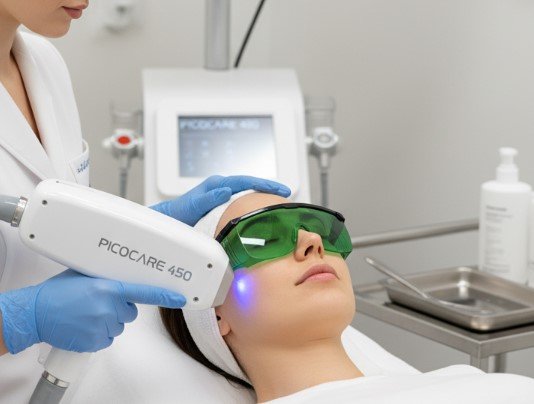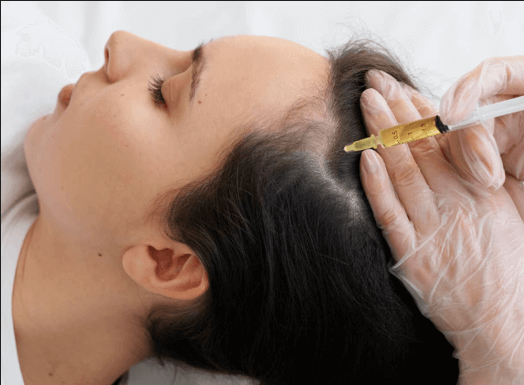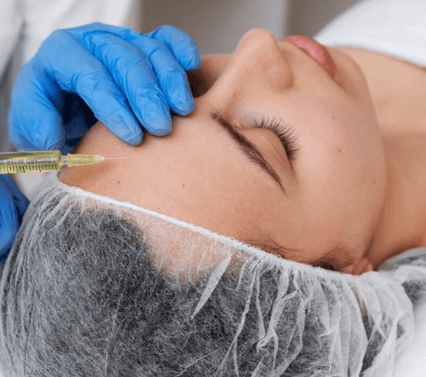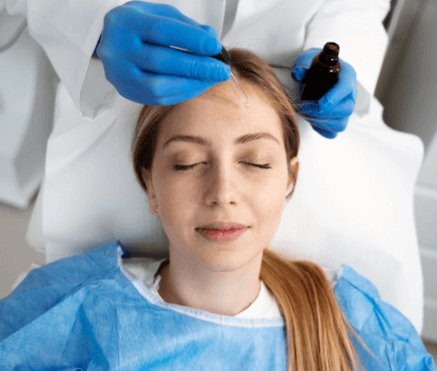Treatment Overview
The Picocare 450 is a picosecond laser system widely used in Korean dermatology clinics for treating sunspots (solar lentigines), freckles, age spots, and other UV-induced pigmentation.
It delivers ultra-short picosecond pulses that break melanin into micro-particles with minimal heat damage to surrounding tissue. This makes it safer for Asian skin types prone to PIH (post-inflammatory hyperpigmentation), while achieving faster and more noticeable pigment clearance compared to older nanosecond lasers.
Purpose & Benefits
- Sunspot Fading: Precisely targets and lightens UV-induced spots.
- Fast Results: Pigment clearance is faster than with older laser systems.
- Safe for Asian Skin: Reduced heat damage lowers risk of PIH.
- Improved Skin Tone: Evens complexion and restores clarity.
- Multi-Functional: Can also address freckles, age spots, and mild acne marks.
Ideal Candidates
Picocare 450 in Korea is recommended for:
- Adults with superficial sunspots or freckles.
- Patients seeking quick pigment removal with fewer sessions.
- Individuals prone to PIH who need safe, controlled treatment.
- Those who want both pigment removal and skin rejuvenation.
Possible Risks & Complications
While considered safe, mild side effects may occur:
- Redness or Warmth: Temporary, fades within hours.
- Temporary Darkening: Spots may darken before flaking off.
- Mild Swelling: Subtle puffiness for 1–2 days.
- Rare Risks: PIH rebound or hypopigmentation if aftercare is neglected.
Surgical Techniques Used
- Picosecond Pulse Technology: Breaks down melanin into fine particles.
- Multiple Wavelength Options (532 nm & 1064 nm): For superficial and deeper pigmentation.
- Low-Fluence Toning or Spot Treatment: Adjusted depending on spot depth.
Protocol: Typically 2–4 sessions, spaced 3–6 weeks apart, with maintenance suggested every 6–12 months.
Recovery & Aftercare
Immediately: Mild redness, tingling, or warmth.
1–3 Days: Treated spots may darken or form micro-crusts.
1–2 Weeks: Pigmentation flakes away, revealing clearer skin.
Aftercare Tips:
- Daily application of SPF 50+ sunscreen.
- Keep skin hydrated with barrier creams.
- Avoid acids, scrubs, or retinoids for 3–5 days.
- Do not pick or scratch scabs.
Results & Longevity
- After 1 Session: Visible lightening of sunspots.
- After 2 Sessions: Noticeable reduction in pigmentation and more even tone.
- After 3–4 Sessions: Significant clearance of most sunspots.
- Long-Term: Results last many months; new sunspots may require touch-ups.
Treatment Process in Korea
Consultation & Skin Analysis
- Dermatologist evaluates sunspot depth, number, and skin type.
Preparation
- Skin cleansing, protective eyewear, optional numbing cream.
Picocare 450 Session
- Step 1: Pigmented spots treated with targeted laser pulses.
- Step 2: Low-fluence passes for overall brightening if needed.
- Step 3: Cooling mask or soothing serum applied post-treatment.
- Duration: 15–25 minutes depending on spot coverage.
Post-Treatment Care
- Sunscreen and hydrating cream applied.
- Patient resumes daily activities immediately with minor restrictions.
Follow-Up
- 2–4 sessions usually recommended for optimal results.
- Can be combined with peels or whitening drips for enhanced results.
Unique Korean Advantages
- Advanced Picosecond Devices: Korea widely uses Picocare 450 for pigment control.
- Safe Protocols for Asian Skin: Fluence and pulse settings designed to minimize PIH.
- Combination Packages: Often paired with whitening serums, Pico toning, or drips.
- Cost-Effective Programs: Multi-session bundles are more affordable than in Western clinics.
Cost Range (Estimated)
- Single Session (Small Spots): USD 150 – 250
- Full Face Session: USD 250 – 400
- 2–4 Session Package: USD 500 – 1,200
- Premium Program (Picocare + Whitening Serums/Boosters): USD 1,200 – 2,000
Additional Costs:
- Consultation: USD 20 – 50
- Add-ons (Vitamin C/TXA infusion, Glutathione drips): USD 100 – 200
- Boosters (PRP, exosomes, Rejuran): USD 200 – 500
Popular Clinics in Seoul
- Oracle Dermatology: Picocare 450 for freckles and sunspots.
- Banobagi Dermatology: Picocare + dual protocols for resistant pigmentation.
- Renewme Skin Clinic: Picocare sessions with brightening serums.
- View Plastic & Dermatology: Picocare + fractional for pigment + texture.
- Chaum Anti-Aging Center: Premium Picocare with regenerative boosters.




